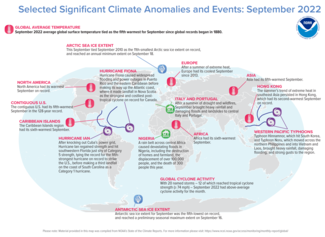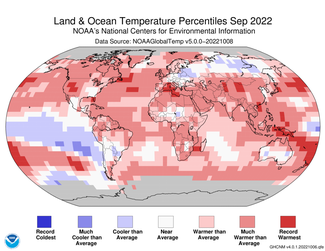Earth had its fifth-warmest September on record

September Highlights:
- September 2022 tied as fifth warmest for the globe.
- North America had its warmest September on record. Asia and Africa had a top-six warm September.
- The Arctic reached its minimum annual sea ice extent on September 18, while the Antarctic very likely reached its annual maximum extent two days prior.
- Above-average September tropical cyclone activity occurred across the globe.
September 2022 tied with 2021 as the globe’s fifth-warmest September in the 143-year NOAA record. The year-to-date (January-September) global surface temperature was the sixth warmest on record. According to NCEI’s Global Annual Temperature Outlook, there is a greater than 99% chance that 2022 will rank among the 10-warmest years on record but less than 5% chance that it will rank among the top five.
This monthly summary, developed by scientists at NOAA’s National Centers for Environmental Information, is part of the suite of climate services NOAA provides to government, business, academia and the public to support informed decision-making.
Monthly Global Temperature
The September global surface temperature was 1.58°F (0.88°C) above the 20th-century average of 59.0°F (15.0°C), tying with 2021 as the fifth-warmest September in the 143-year record. September 2022 marked the 46th consecutive September and the 453nd consecutive month with temperatures, at least nominally, above the 20th-century average.
Temperatures were much above average across most of North America, Africa, the southern half of Asia, the Atlantic, northern, western and southern Pacific oceans, as well as parts of northern South America. Temperatures were near- to cooler-than-average across parts of Europe, northern Asia, Australia, southern South America, and the central and eastern tropical, southeastern Pacific Ocean. However, no land or ocean surfaces had a record-cold September.
Regionally, North America had its warmest September on record, surpassing the previous record set in 2019 by 0.54°F (0.30°C). Asia and Africa had their fifth and sixth warmest September on record, respectively. Meanwhile, South America and Europe had their coolest September since 2013, despite having above-average temperatures. Oceania also had an above-average September temperature, but it didn’t rank among the 20 warmest on record.
Sea Ice
Globally, September 2022 had the eighth-lowest September sea ice extent on record.
Arctic sea ice extent in September averaged 1.88 million square miles, which is about 595,000 square miles below the 1981-2010 average and tied with 2010 as the 11th-smallest September extent in the 44-year record. According to the National Snow and Ice Data Center (NSIDC), the Arctic sea ice extent reached its annual minimum extent on September 18, marking the end of the melt season. The 2022 annual Arctic minimum extent was 1.80 million square miles, tying with 2017 and 2018 as the 10th smallest since records began in 1979. The 16 smallest annual minimum extents have all occurred in the last 16 years (2007-2022).
Antarctica had its fifth-smallest September sea ice extent on record at 6.95 million square miles or 190,000 square miles below average. According to NSIDC, it is very likely the Antarctic reached its annual maximum extent on September 16 at 7.02 million square miles, marking the end of the Antarctic's growth season.
Global Precipitation
Above-average September precipitation was observed across parts of the Caribbean, the southeastern contiguous U.S., central Europe, northern and southern parts of Asia, and across parts of Australia. Parts of Africa also had wetter-than-average conditions. Of note, copious rainfall triggered deadly floods and landslides across Nigeria, Uganda, and Senegal. Tropical cyclones across the globe triggered devastating floods across the Caribbean, Central America, Mexico, the southeastern contiguous U.S., eastern Asia, and eastern Canada. Meanwhile, drier-than-average conditions were present across parts of the central contiguous U.S., southern South America, and eastern Asia.
Global Tropical Cyclones
Global tropical cyclone activity was above average in September, with a total of 20 named storms. Twelve of those storms reached tropical cyclone strength (≥ 74 mph), with six of the 12 reaching major tropical cyclone intensity (≥ 111 mph). Following no tropical cyclone activity in August, the Atlantic basin had six named storms in September, four which became hurricanes, including two major tropical cyclones: Hurricanes Fiona and Ian. Fiona produced devastating floods across the Caribbean Islands and impacted Canada as a post-tropical cyclone. Ian caused widespread damages across Cuba and the southeastern contiguous U.S. The East Pacific and the West Pacific basins also had an above-average tropical cyclone activity during the month. The West Pacific had seven storms, all of which reached typhoon strength – tying with 1956 and 1996 as the most typhoons in September since 1981.
For a more complete summary of climate conditions and events, see our September 2022 Global Climate Report.






